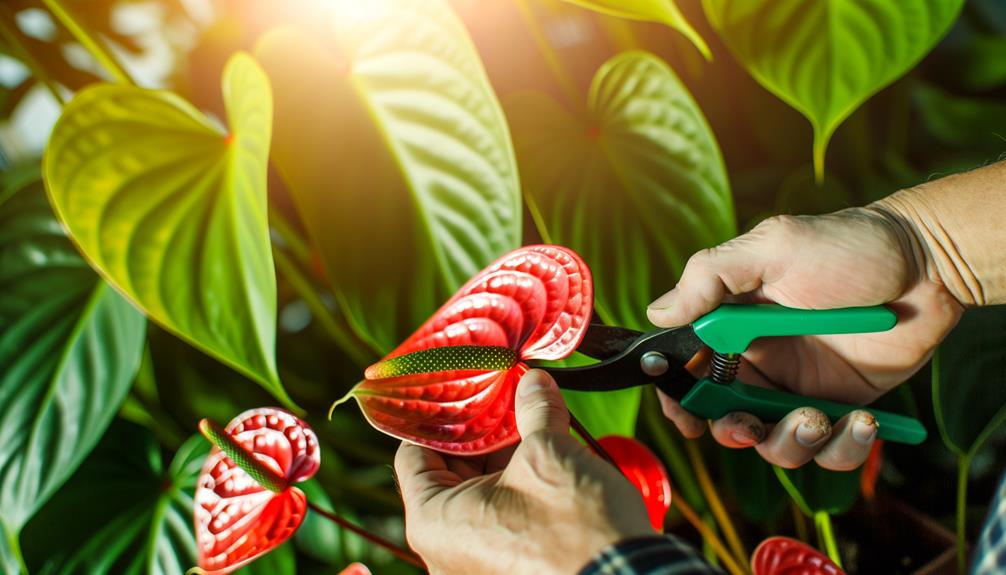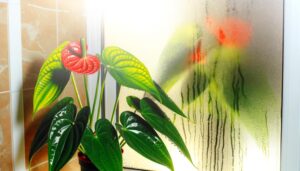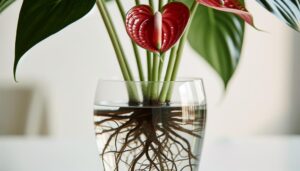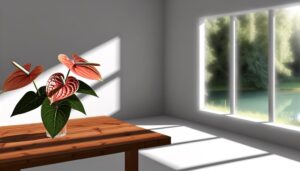5 Easy Steps to Cut Dead Flowers Off Anthurium
To trim wilted flowers off your Anthurium, start by gathering sharp pruning shears, rubbing alcohol, and disposable gloves. Identify dead flowers by their discoloration, wilting, or dullness.
Make sure the plant is well-hydrated and placed in bright, indirect light. Sterilize your tools, then make a clean cut just above the base of the flower stem, using firm, decisive motion to protect the plant's vascular system.
Immediately discard the cut flowers and sterilize your tools again to prevent disease spread. Continue for more detailed instructions and tips to keep your Anthurium thriving.

Key Takeaways
- Inspect the Anthurium for dead flowers, looking for discoloration, wilting, or loss of vibrancy.
- Sterilize sharp pruning shears with rubbing alcohol to prevent disease.
- Cut dead flowers just above the base of the stem at an angle.
- Dispose of removed flowers in a sealed plastic bag to prevent pest or disease transfer.
- Clean pruning shears and sweep up any plant debris to maintain a healthy environment.
Gather Your Tools
To commence the process of cutting dead flowers off your Anthurium, you'll need to gather necessary tools such as sharp pruning shears, rubbing alcohol, and disposable gloves. Confirm your pruning shears are sterilized by wiping the blades with rubbing alcohol. This step prevents the transmission of pathogens that could harm your plant.
Disposable gloves protect your hands from any sap that may cause irritation. Also, have a clean cloth or paper towels nearby to wipe your tools if needed. Proper sanitation is pivotal for maintaining plant health.
Identify Dead Flowers
Recognizing the signs of a dead flower on your Anthurium involves examining the bloom for discoloration, wilting, or a lack of vibrant sheen.
First, observe the spathe and spadix for any browning or yellowing, indicating senescence. A healthy spathe should exhibit a glossy, waxy texture; when this diminishes, it signifies decline.
Next, inspect for wilting, where the flower might droop or lose its structural rigidity, a clear indicator of its demise.
Additionally, assess the overall vibrancy; a flower past its prime will lack the customary vividness and appear dull.
Prepare the Plant
Before cutting dead flowers off your Anthurium, make sure the plant is well-hydrated and situated in a well-lit area to minimize stress during the pruning process.
Water the Anthurium thoroughly, ensuring the soil is moist but not waterlogged, as this helps the plant maintain turgor pressure and reduces shock. Position the plant in indirect, bright light to facilitate best photosynthesis and overall health.
Inspect the foliage and flowers to confirm the plant is free of pests or diseases, which could complicate pruning. Gather sterilized pruning shears or scissors to prevent introducing pathogens. Clean your tools with isopropyl alcohol before use.
Make the Cut
With your Anthurium properly prepared, identify the dead or dying flowers, which typically exhibit discoloration or wilting, and position your sterilized pruning shears just above the base of the flower stem for a best cut. Make sure that the blade is angled to allow for a clean, swift incision, minimizing damage to the surrounding tissues.
This precise cut encourages optimal regrowth by preventing unnecessary stress to the plant's vascular system. Be vigilant in avoiding the healthy parts of the stem, concentrating solely on the affected areas.
Execute the cut with a firm, decisive motion to prevent jagged edges, which can invite pathogens. This method maintains the plant's overall health and promotes future blooming cycles.
Dispose and Clean Up
After cutting, promptly dispose of the removed flowers to prevent any potential spread of disease or pests. Place the spent blooms in a sealed plastic bag before discarding them in the trash. This minimizes the risk of pathogens or insects transferring to other plants.
Next, clean your pruning shears with rubbing alcohol or a diluted bleach solution (one part bleach to nine parts water) to sterilize them. This step is essential to avoid cross-contamination during future pruning sessions.
Sweep up any fallen plant debris around the base of the Anthurium to maintain a clean growing environment. This helps reduce the likelihood of fungal growth or pest infestation.
Conclusion
With tools gathered and dead flowers identified, you've prepared your anthurium for a rejuvenating trim. Make precise cuts, ensuring the plant's health and vitality.
Dispose of the clipped parts properly, and clean your tools to prevent disease. Like a maestro conducting a symphony, your careful actions will encourage new growth and vibrant blooms.
By following these steps, you've not only tidied your plant but also nurtured its botanical brilliance for future flourishing.






